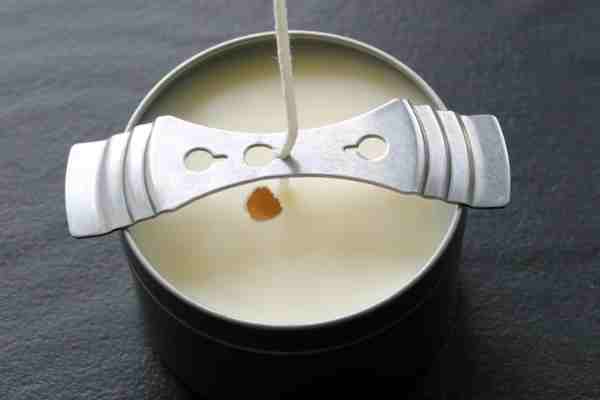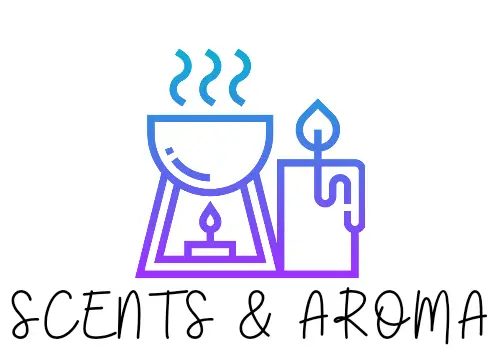Sinkholes are the nemesis of most candles – and the candlemaker. Regardless of how meticulous you are or the type of candle, a sinkhole can still occur.

What are sinkholes in candles?
First off I just want to tell you what I am referring to when I say a candle sinkhole.
So what is a candle sinkhole?
Sinkholes are openings like a crater around the candlewick. They can vary in depth and size and can affect wick functionality, causing the candle wick to burn too fast and are also a major contributing factor when it comes to tunnelling of the candle.
That is what a sinkhole in candle making means. It’s like a pit or crater that appears next to the wick. Believe it or not it is a common problem and happens even to seasoned candle makers.
let’s now take a brief look at why sinkholes form in candles.
Why do candles get sinkholes?
Now that we know what a candle sinkhole is we need to work out why it occurs. Below is a short but sweet reasoning before we tale a deeper delve into it and also some steps you can take to minimise the chances of it occurring.
Why do candles sink in the middle?
Sinkholes occur when the wax pouring temperature is too low. The candles sink in the middle when the hardened wax won’t bond to the wick. When the candle cools too quickly, the wax on top dries and leaves the wax underneath warm. This process causes the wax to sink as it continues to dry. If the wax in the center of the container hardens slower than the wax outside the container, it will take up more space and result in a sinkhole.
As far as the technicalities are concerned, that is why your homemade candle sinks in the middle. But beyond the technicalities, let us break the reasons down into simpler chunks.
How cooling temperature affects your candle
Candle sinkholes occur naturally when the wax is set up. When you heat up your wax, it melts into liquid, expands, and takes up more space. Then, you pour it into a jar and wait for it to harden.
However, when the wax cools, it hardens and begins to retract or shrink. In other words, the wax that was hot and expanded will start to contract. But when the wax cools too quickly, it hardens without filling the open areas.
During cooling, wax needs to stick to something. To do this, it starts to stick to the sides. This pulls wax away from the middle and causes it to sink. Apart from this, your wax may also stick to the wick. However, the middle will continue to sink as it cools down further.
The temperature really is everything. However, there are various other factors in play while your candle cools and sets.
The room temperature
The best room temperature for setting your candle, together with ventilation, is around 70-degrees without any breeze or drafts. If your room is too cool, the bottom of the candle and the outside edges will cool faster than the center. Then, the wax will harden on the outside edge, and the center will sink in.
Wax temperature
Apart from the room temperature, the wax temperature also determines if a sinkhole will occur or not. For example, if the wax center is extremely hot and the edges are not, the center will stay hot for an extended period. Then, a sinkhole will form. To avoid this, you must pour your wax at an even temperature to ensure uniform cooling.
Container temperature
Like room temperature, the container temperature also affects the formation of a sinkhole. Cool containers will encourage a sinkhole formation since the sides will harden faster.
3 simple steps to stop candle sinkholes
Below are 3 simple steps that you can take which will reduce the chances of your candle sinking in the middle and creating a sinkhole.
The preparation
Like the saying, “proper preparation prevents poor performance,” adequate preparation will help you avoid future problems.
Use a warm room and container
You already know that you must monitor the temperature to achieve the best results for your candle. Therefore, keep your room and container warm when pouring your candles. You can close the window and switch off the air conditioner to maintain a balanced temperature.
Also, warm up the containers to prevent wax from hardening on the container sides. You can do this in an oven on its lowest setting for about 15 minutes with the door open. You can also use a heat gun before pouring your candles.
Doing this will also stop your candle from having wet spots on the sides.
Use the appropriate wax types at a low temperature
Not all waxes are to the same in design and function. As a result, using the wrong wax type for your candle can cause a sinkhole. Apart from this make sure the wax is designed for the container. After determining the right wax, pour it at a low temperature.
3 simple ways to fix a candle sinkhole
It can feel like the end of the world when your candle develops a sinkhole. Candles take time to make and when made in batches and a few start sinking in the middle it can be a sad moment.
However don’t despair, follow the 3 methods below to repair your candles sinkhole.
Fix with a second pour
After the first pour solidifies and cools off, try a second pour. Leave a space of two hours between the two pours. Also, don’t pour too fast and don’t use too much wax so you don’t repeat the first mistake and create a second hole.
For the second pour, introduce your candle wax normally over the thick layer on the top. Make sure the second pour is hot enough to melt into the first layer and blend the two waxes. Poke your candle with a toothpick to make sure the hole is filled.
Use a heat gun
You can use a heat gun to eliminate surface flaws on your candle or warm the containers before pouring. Hold the gun about 8-inches away from the candle and rotate in a circular motion to melt the wax. Do this until it fills the sinkhole.
Since you can use a heat gun to smoothen candle surface flaws, you can use it even if you don’t spot a sinkhole.
Use a hair dryer or oven
If you don’t have a heat gun, use a hairdryer to heat and melt the surface wax until it fills the holes. Alternatively, use an oven at a low temperature, but only heat the upper wax layer. Do it slowly so that you don’t melt the entire candle.
Conclusion
A sinkhole is nothing to worry or stress on. If you can get the preparation right, you won’t have a problem. You will significantly reduce the chances of a sinkhole if you control the temperature you are working with. It will also help if you can get the procedure right on your first pour.
But what do you do when a sinkhole occurs? Fix it. As we said, you can either avoid a sinkhole entirely or fix it. Regardless, it is not a problem you can’t solve.
- Can You Put Perfume In A Humidifier? (Read First) - September 17, 2022
- Can You Put Essential Oil In A Steam Mop? (Safety Advice) - September 17, 2022
- How To Make Lavender Oil At Home ( Candles And Diffusers) - September 9, 2022

